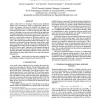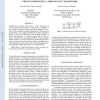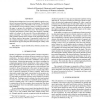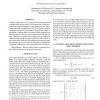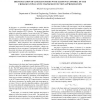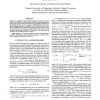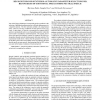121
click to vote
ICASSP
2008
IEEE
15 years 6 months ago
2008
IEEE
Audio coding based on Frequency Domain Linear Prediction (FDLP) uses auto-regressive model to approximate Hilbert envelopes in frequency sub-bands for relatively long temporal seg...
ICASSP
2008
IEEE
15 years 6 months ago
2008
IEEE
Identification of prosodic phenomena is of first importance in prosodic analysis and modeling. In this paper, we introduce a new method for automatic prosodic phenomena labellin...
ICASSP
2008
IEEE
15 years 6 months ago
2008
IEEE
Recently, we successfully developed and reported a new unsupervised online adaptation technique, which jointly compensates for additive and convolutive distortions with vector Tay...
102
click to vote
ICASSP
2008
IEEE
15 years 6 months ago
2008
IEEE
Missing data techniques have been recently applied to speaker recognition to increase performance in noisy environments. The drawback of these techniques is the vulnerability of t...
87
Voted
ICASSP
2008
IEEE
15 years 6 months ago
2008
IEEE
Tandem connections of voice codecs can occur today in mobileto-mobile calls and for certain VoIP connections. While postfiltering in tandem encodings is well-understood, the effe...
103
Voted
ICASSP
2008
IEEE
15 years 6 months ago
2008
IEEE
In this paper, we extend the cross-multiplicative transfer function (CMTF) approach for improved system identification in the shorttime Fourier transform (STFT) domain. The propo...
ICASSP
2008
IEEE
15 years 6 months ago
2008
IEEE
Relying on optimally distinguishable distributions (ODD), it was defined very recently a new framework for the composite hypothesis testing. We resort to the linear model to inve...
100
click to vote
ICASSP
2008
IEEE
15 years 6 months ago
2008
IEEE
One of the biggest challenges in emotional speech resynthesis is the selection of modification parameters that will make humans perceive a targeted emotion. The best selection me...
ICASSP
2008
IEEE
15 years 6 months ago
2008
IEEE
Past research on automatic laughter detection has focused mainly on audio-based detection. Here we present an audiovisual approach to distinguishing laughter from speech and we sh...
62
Voted
ICASSP
2008
IEEE
15 years 6 months ago
2008
IEEE
